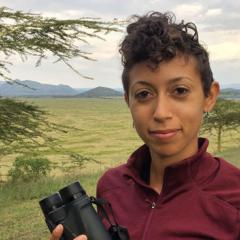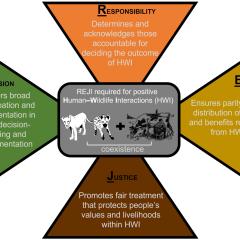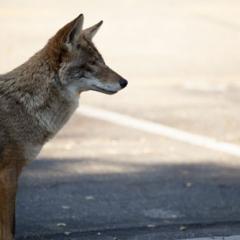Wilkinson links human-coyote conflict and social-ecological factors
Editor’s note: Content in this story originally appeared as a plain language summary in the Relational Thinking blog by Christine E. Wilkinson, Tal Caspi, Lauren A. Stanton, Deb Campbell, and Christopher J. Schell.
A 2023 study co-authored by Christine Wilkinson explored how social--ecological factors and pollution burden are linked with human-coyote conflict reports in San Francisco, California. In a recent story by the Wildlife Society, she said “The city is saturated with coyotes—the packs that are there are largely the packs that will remain there… [human-coyote encounters are] something that we need to better plan for in the Bay area and also in California as a whole.”
Global change is increasing the frequency and severity of human-wildlife interactions as people and wildlife increasingly share spaces with limited resources. Cities are a microcosm of these interactions, demonstrating how social, cultural, and ecological factors can work together to drive human-wildlife interactions. Coyotes (Canis latrans) are arguably the most successful urban carnivores in North America. Having expanded their range across the United States, they now frequently interact with people in urban environments. San Francisco, California likely has one of the highest urban densities of coyotes in the USA, making it an excellent region for analyzing human-coyote interactions and attitudes toward coyotes over time and space and drawing broader conclusions that may guide coexistence between people and urban wildlife.
The authors used a community-curated long-term data source from San Francisco Animal Care and Control, the city-funded animal shelter and animal first responder unit, to analyze a decade of coyote sightings and human-coyote interactions in San Francisco, from 2012-2022. Specifically, they characterized the patterns in human attitudes and human-coyote interactions in relation to housing density, median income, road density, pollution burden, human vulnerability, vegetation, and urban green space access. They found that human-coyote conflict reports have been increasing over the past 5 years, and that there were more conflict reports during pup-rearing season (April-June), the driest seasons (June-September), and the COVID-19 pandemic. Conflict reports were more likely to involve dogs—especially off-leash dogs—and to disproportionately occur inside of parks. Conflict reports were also more likely in places with higher-quality vegetation and higher median income. Meanwhile, reported coyote boldness, non-lethal hazing (scaring off) of coyotes, and human attitudes toward coyotes were correlated with pollution burden and human population vulnerability.
Our results demonstrate that human-coyote interactions are associated with both social and ecological factors, and that coexistence with urban wildlife will thus require socially-informed strategies. To build management strategies for urban human-wildlife coexistence, the authors recommend additional research and outreach efforts that intentionally involve diverse community members and consider within-city differences in social factors and human vulnerability.
Learn more:
Wilkinson, C. E., Caspi, T., Stanton, L. A., Campbell, D., & Schell, C. J. (2023). Coexistence across space and time: Social-ecological patterns within a decade of human-coyote interactions in San Francisco. People and Nature, 5, 2158–2177. https://doi.org/10.1002/pan3.1054
UNCOVERING TRENDS IN COYOTE-HUMAN CONFLICT CAN AID IN COEXISTENCE, The Wildlife Society, Joshua Rapp Learn.
![A coyote runs across a street near pedestrians in Golden Gate Park, San Francisco. Photo credit: Stephen Riffle [Twitter: @EyaSpectre]](/sites/default/files/styles/3x2_small/public/images/coyote%20and%20joggers_Stephen%20Riffle_Twitter_EyaSpectre.jpg?h=a4df990e&itok=yyv95tNV)


